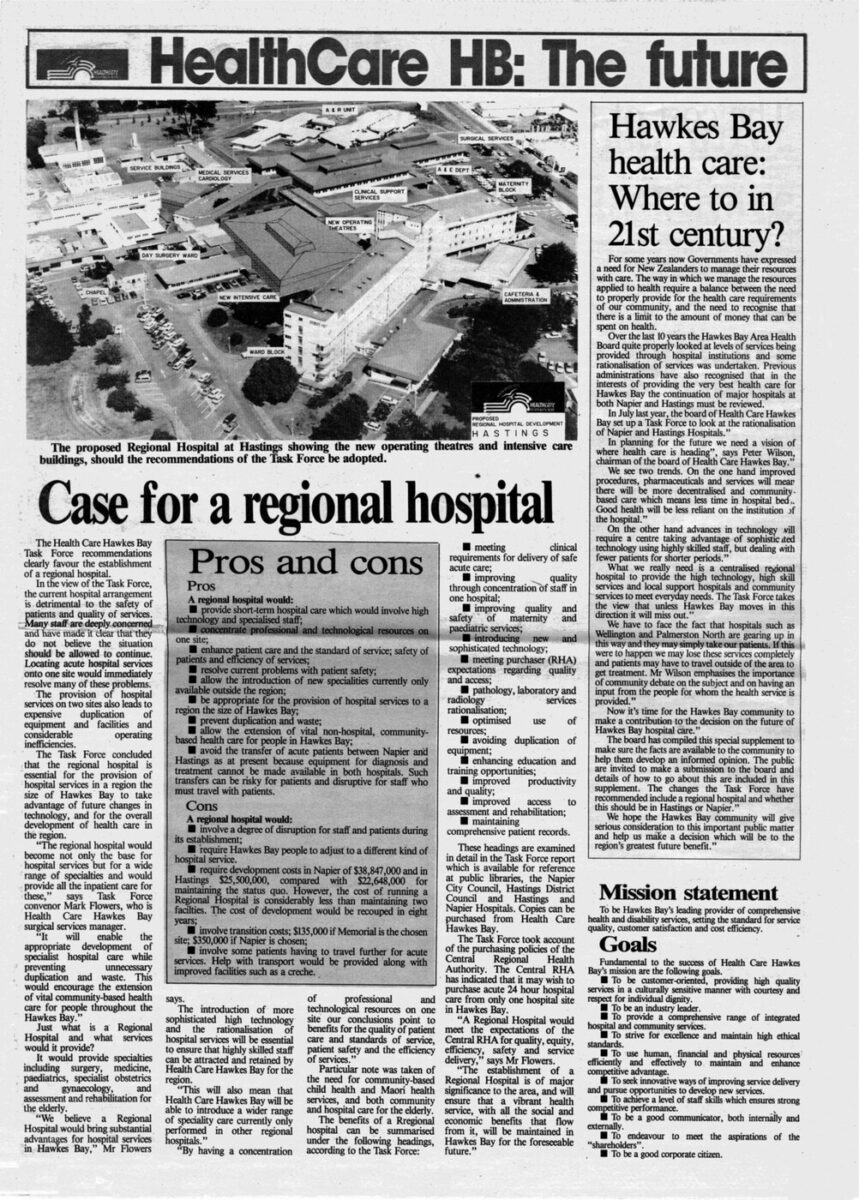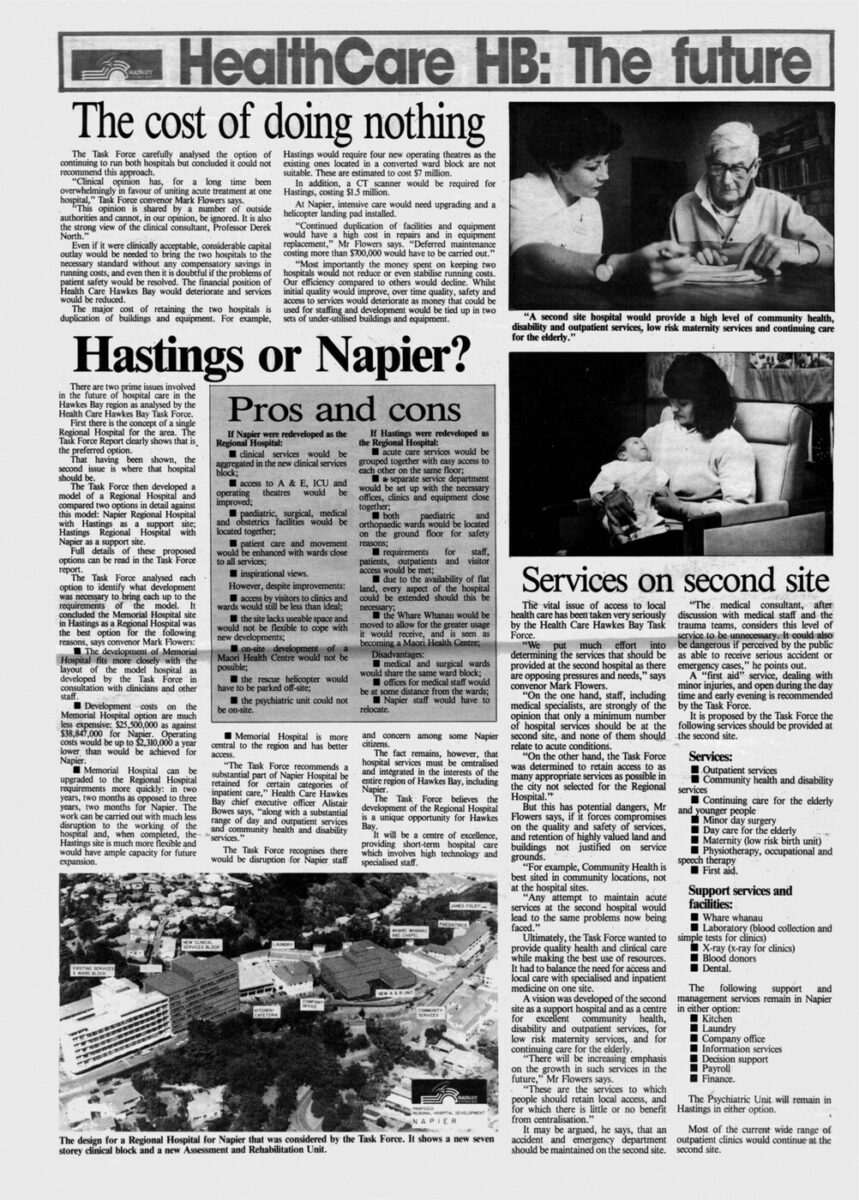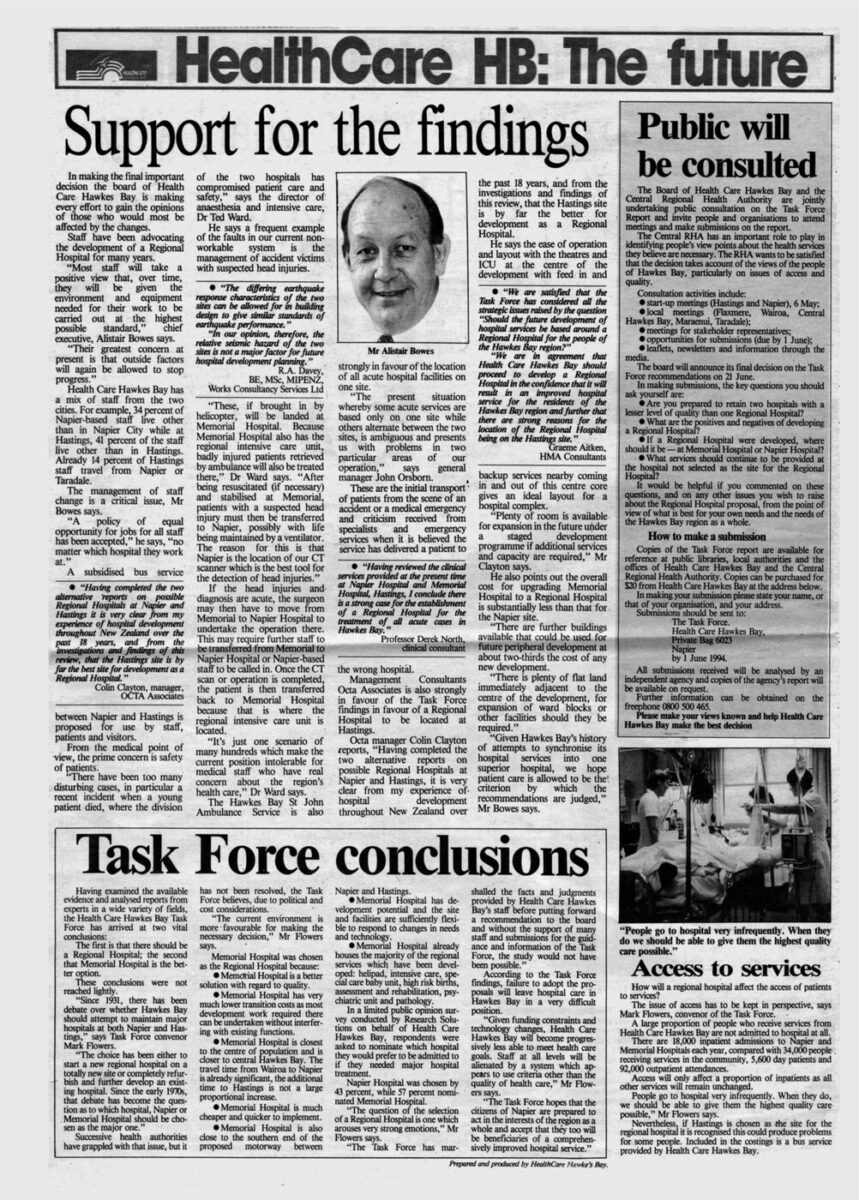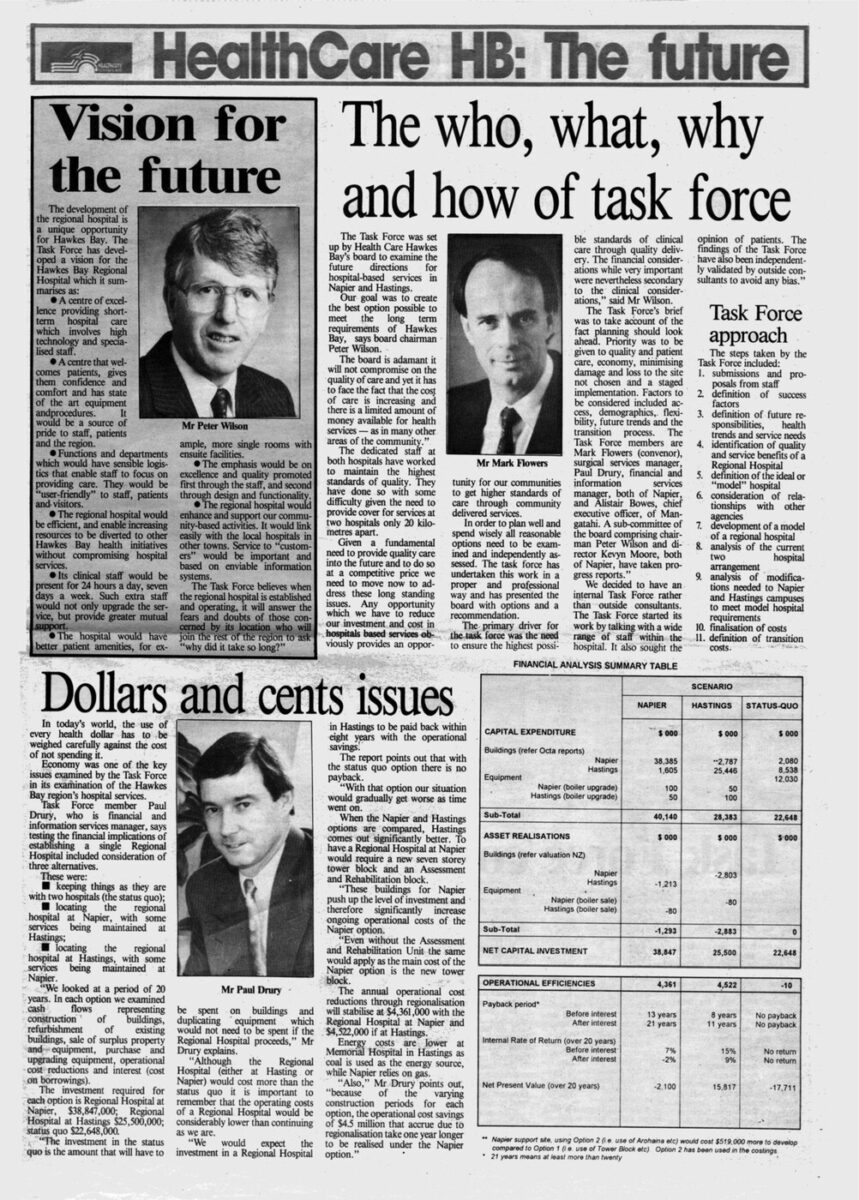- Home
- Collections
- POPPELWELL MD
- Newspaper Articles
- Newspaper Supplement 1994 - Healthcare HB: The future
Newspaper Supplement 1994 – Healthcare HB: The future
HealthCare HB: The Future
Case for a regional hospital
The Health Care Hawkes Bay Task Force recommendations clearly favour the establishment of a regional hospital.
In the view of the Task Force, the current hospital arrangement is detrimental to the safety of patients and quality of services. Many staff are deeply concerned and have made it clear that they do not believe the situation should be allowed to continue. Locating acute hospital services onto one site would immediately resolve many of these problems.
The provision of hospital services on two sites also leads to expensive duplication of equipment and facilities and considerable operating inefficiencies.
The Task Force concluded that the regional hospital is essential for the provision of hospital services in a region the size of Hawkes Bay to take advantage of future changes in technology, and for the overall development of health care in the region.
“The regional hospital would become not only the base for hospital services but for a wide range of specialties and would provide all the inpatient care for these,” says Task Force convenor Mark Flowers, who is Health Care Hawkes Bay surgical services manager.
“It will enable the appropriate development of specialist hospital care while preventing unnecessary duplication and waste. This would encourage the extension of vital community-based health care for people throughout the Hawkes Bay.”
Just what is a Regional Hospital and what services would it provide?
It would provide specialties including surgery, medicine, paediatrics, specialist obstetrics and gynaecology, and assessment and rehabilitation for the elderly.
“We believe a Regional Hospital would bring substantial advantages for hospital services in Hawkes Bay,” Mr Flowers says.
The introduction of more sophisticated high technology and the rationalisation of hospital services will be essential to ensure that highly skilled staff can be attracted and retained by Health Care Hawkes Bay for the region.
“This will also mean that Health Care Hawkes Bay will be able to introduce a wider range of speciality care currently only performed in other regional hospitals.”
“By having a concentration of professional and technological resources on one site our conclusions point to benefits for the quality of patient care and standards of service, patient safety and the efficiency of services.”
Particular note was taken of the need for community-based child health and Maori health services, and both community and hospital care for the elderly.
The benefits of a Regional [Regional] hospital can be summarised under the following headings, according to the Task Force:
meeting clinical requirements for delivery of safe acute care;
improving quality through concentration of staff in one hospital;
improving quality and safety of maternity and paediatric services;
introducing new and sophisticated technology;
meeting purchaser (RHA) expectations regarding quality and access;
pathology, laboratory and radiology services rationalisation;
optimised use of resources;
avoiding duplication of equipment;
enhancing education and training opportunities;
improved productivity and quality;
improved access to assessment and rehabilitation;
maintaining comprehensive patient records.
These headings are examined in detail in the Task force report which is available for reference at public libraries, the Napier City Council, Hastings District Council and Hastings and Napier Hospitals. Copies can be purchased from Health Care Hawkes Bay.
The Task Force took account of the purchasing policies of the Central Regional Health Authority. The Central RHA has indicated that it may wish to purchase acute 24 hour hospital care from only one hospital site in Hawkes Bay.
“A Regional Hospital; would meet the expectations of the Central RHA for quality, equity, efficiency, safety and service delivery,” says Mr Flowers.
“The establishment of a Regional Hospital is of major significance to the area, and will ensure that a vibrant health service, with all the social and economic benefits that flow from it, will be maintained in Hawkes Bay for the foreseeable future.”
Pros and Cons
Pros
A regional hospital would:
provide short-term hospital care which would involve high technology and specialised staff;
concentrate professional and technological resources on one site;
enhance patient care and the standard of service, safely of patients and efficiency of services;
resolve current problems with patient safety;
allow the introduction of new specialities currently only available outside the region;
be appropriate for the provision of hospital services to a region the size of Hawkes Bay;
prevent duplication and waste;
allow the extension of vital non-hospital, community-based health care for people in Hawkes Bay;
avoid the transfer of acute patients between Napier and Hastings as at present because equipment for diagnosis and treatment cannot be made available in both hospitals. Such transfers can be risky for patients and disruptive for staff who must travel with patients.
Cons
A regional hospital would:
involve a degree of disruption for staff and patients during its establishment;
require Hawkes Bay people to adjust to a different kind of hospital service.
require development costs in Napier of $38,847,000 and in Hastings $25,500,000, compared with $22,648,000 for maintaining the status quo. However, the cost of running a Regional Hospital is considerably less than maintaining two facilities. The cost of development would be recouped in eight years;
involve transition costs; $135,000 if Memorial is the chosen site; $350,000 if Napier is chosen;
involve some patients having to travel further for acute services. Help with transport would be provided along with improved facilities such as a creche.
Hawkes Bay health care: Where to in 21st century?
For some years now Governments have expressed a need for New Zealanders to manage their resources with care. The way in which we manage the resources applied to health require a balance between the need to properly provide for the health care requirements of our community, and the need to recognise that there is a limit to the amount of money that can be spent on health.
Over the last 10 years the Hawkes Bay Area Health Board quite properly looked at levels of services being provided through hospital institutions and some rationalisation of services was undertaken. Previous administrations have also recognised that in the interests of providing the very best health care for Hawkes Bay the continuation of major hospitals at both Napier and Hastings must be reviewed.
In July last year, the board of Health Care Hawkes Bay set up a Task Force to look at the rationalisation of Napier and Hastings Hospitals.”
In planning for the future we need a vision of where health care is heading”, says Peter Wilson, Chairman of the board of Health Care Hawkes Bay.”
We see two trends. On the one hand improved procedures, pharmaceuticals and services will mean there will be more decentralised and community-based care which means less time in hospital bed. Good health will be less reliant on the institution of the hospital.”
On the other hand advances in technology will require a centre taking advantage of sophisticated technology using highly skilled staff, but dealing with fewer patients for shorter periods.”
What we really need is a centralised regional hospital to provide the high technology, high skill services and local support hospitals and community services to meet everyday needs. The Task Force takes the view that unless Hawkes Bay moves in this direction it will miss out.”
We have to face the fact that hospitals such as Wellington and Palmerston North are gearing up in this way and they may simply take our patients. If this were to happen we may lose these services completely and patients may have to travel outside of the area to get treatment. Mr Wilson emphases the importance of community debate on the subject and on having an input from the people for whom the health service is provided.”
Now it’s time for the Hawkes Bay community to make a contribution to the decision on the future of Hawkes Bay hospital care.”
The board has compiled this special supplement to make sure the facts are available to the community to help them develop an informed opinion. The public are invited to make a submission to the board and details of how to go about this are included in this supplement. The changes the Task Force have recommended include a regional hospital and whether this should be in Hastings or Napier.”
We hope the Hawkes Bay community will give serious consideration to this important public matter and help us make a decision which will be to the region’s greatest future benefit.”
Mission statement
To be Hawkes Bay’s leading provider of comprehensive health and disability services, setting the standard for service quality, customer satisfaction and cost efficiency.
Goals
Fundamental to the success of Health Care Hawkes Bay’s mission are the following goals.
To be customer-oriented, providing high quality services in a culturally sensitive manner with courtesy and respect for individual dignity.
To be an industry leader.
To provide a comprehensive range of integrated hospital and community services.
To strive for excellence and maintain high ethical standards.
To use human, financial and physical resources efficiently and effectively to maintain and enhance competitive advantage.
To seek innovative ways of improving service delivery and pursue opportunities to develop new services.
To achieve a level of staff skill which ensures strong competitive performance.
To be a good communicator, both internally and externally.
To endeavour to meet the aspirations of the “shareholders”.
To be a good corporate citizen.
Photo caption – The proposed Regional Hospital at Hastings showing the new operating theatres and Intensive care buildings, should the recommendations of the Task Force be adopted.

HealthCare HB: The future
The cost of doing nothing
The Task Force carefully analysed the option of continuing to run both hospitals but concluded it could not recommend this approach.
“Clinical opinion has, for a long time been overwhelmingly in favour of uniting acute treatment at one hospital,” Task Force convenor Mark Flowers says.
“This opinion is shared by a number of outside authorities and cannot, in our opinion, be ignored. It is also the strong view of the clinical consultant, Professor Derek North.”
Even if it were clinically acceptable, considerable capital outlay would be needed to bring the two hospitals to the necessary standard without any compensatory savings in running costs, and even then it is doubtful if the problems of patient safety would be resolved. The financial position of Health Care Hawkes Bay would deteriorate and services would be reduced.
The major cost of retaining the two hospitals is duplication of buildings and equipment. For example, Hastings would require four new operating theatres as the existing ones located in a converted ward block are not suitable. These are estimated to cost $7 million.
In addition, a CT scanner would be required for Hastings, costing $1.5 million.
At Napier, intensive care would need upgrading and a helicopter landing pad installed.
“Continued duplication of facilities and equipment would have a high cost in repairs and in equipment replacement,” Mr Flowers says.
“Deferred maintenance costing more than $700,000 would have to be carried out.”
“Most importantly the money spent on keeping two hospitals would not reduce or even stabilise running costs. Our efficiency compared to others would decline. Whilst initial quality would improve, over time quality, safety and access to services would deteriorate as money that could be used for staffing and development would be tied up in two sets of under-utilised buildings and equipment.
Hastings or Napier?
There are two prime issues involved in the future of hospital care in the Hawkes Bay region as analysed by the Health Care Hawkes Bay Task Force.
First there is the concept of a single Regional Hospital for the area. The Task Force Report clearly shows that is the preferred option.
That having been shown, the second issue is where that hospital should be.
The Task Force then developed a model of a Regional Hospital and compared two options in detail against this model: Napier Regional Hospital with Hastings as a support site; Hastings Regional Hospital with Napier as a support site.
Full details of these proposed options can be read in the Task Force report.
The Task Force analysed each option to identify what development was necessary to bring each up to the requirements of the model. It concluded the Memorial Hospital site in Hastings as a Regional Hospital was the best option for the following reasons, says convenor Mark Flowers:
The development of Memorial Hospital fits more closely with the layout of the model hospital as developed by the Task Force in consultation with clinicians and other staff.
Development costs on the Memorial Hospital option are much less expensive: $25,500,000 as against $38,847,000 for Napier. Operating costs would be up to $2,310,000 a year lower than would be achieved for Napier.
Memorial Hospital can be upgraded to the Regional Hospital requirements more quickly: in two years, two months as opposed to three years, two months for Napier. The work can be carried out with much less disruption to the working put with much less disruption to the working of the hospital and, when completed, the Hastings site is much more flexible and would have ample capacity for future expansion.
Memorial Hospital is more central to the region and has better access.
“The Task Force recommends a substantial part of Napier Hospital be retained for certain categories of inpatient care,” Health Care Hawkes Bay chief executive officer Alistair Bowes says, “along with a substantial range of day and outpatient services and community health and disability services.”
The Task Force recognises there would be disruption for Napier staff and concern among some Napier citizens.
The fact remains, however, that hospital services must be centralised and integrated in the interest of the entire region of Hawkes Bay, including Napier.
The Task Force believes the development of the Regional Hospital is a unique opportunity for Hawkes Bay.
It will be a centre of excellence, providing short-term hospital care which involves high technology and specialised staff.
Pros and cons
If Napier were redeveloped as the Regional Hospital:
clinical services would be aggregated in the new clinical service block;
access to A & E, ICU and operating theatres would be improved;
paediatric, surgical, medical and obstetrics facilities would be located together;
patient care and movement would be enhanced with wards close to all services;
inspirational views.
However, despite improvements:
access by visitors to clinics and wards would still be less than ideal;
the site lacks useable space and would not be flexible to cope with new developments;
on-site development of a Maori Health Centre would not be possible;
the rescue helicopter would have to be parked off-site;
the psychiatric unit could not be on-site.
If Hastings were developed as the Regional Hospital:
acute care services would be grouped together with easy access to each other on the same floor;
a separate service department would be set up with the necessary offices, clinics and equipment close together;
both paediatric and orthopaedic wards would be located on the ground floor for safety reasons;
requirements for staff, patients, outpatients and visitor access would be met;
due to the availability of flat land, every aspect of the hospital could be extended should this be necessary;
the Whare Whanau would be moved to allow for the greater usage it would receive, and is seen as becoming a Maori health Centre;
Disadvantages:
medical and surgical wards would share the same ward block;
offices for medical staff would be at some distance from the wards;
Napier staff would have to relocate.
Services on second site
The vital issue of access to local health care has been taken very seriously by the Health Care Hawkes Bay Task Force.
“We put much effort into determining the services that should be provided at the second hospital as there are opposing pressures and needs,” says convenor Mark Flowers.
“On the one hand, staff, including medical specialists, are strongly of the opinion that only a minimum number of hospital services should be at the second site, and none of them should relate to acute conditions.
“On the other hand, the Task Force was determined to retain access to as many appropriate services as possible in the city not selected for the Regional Hospital.”
But this has potential dangers, Mr Flowers says, if it forces compromises on the quality and safety of services, and retention of highly valued land and buildings not justified on service grounds.
“For example, Community Health is best sited in community locations, not at the hospital sites.
“Any attempt to maintain acute services at the second hospital would lead to the same problems now being faced.”
Ultimately, the Task Force wanted to provide quality health and clinical care while making the best use of resources. It had to balance the need for access and local care with specialised and inpatient medicine on one site.
A vision was developed of the second site as a support hospital and as a centre for excellent community health, disability and outpatient services, for low risk maternity services, and for continuing care for the elderly.
“There will be increasing emphasis on the growth in such services in the future,” Mr Flowers says.
“These are the services to which people should retain local access, and for which there is little or no benefit from centralisation.”
It may be argued, he says, that an accident and emergency department should be retained on the second site.
“The medical consultant, after discussion with medical staff trauma teams, considers this level of service to be unnecessary. It could also be dangerous if perceived by the public as able to receive serious accident of emergency cases,” he points out.
A “First aid” service, dealing with minor injuries, and open during the day time and early evening is recommended by the Task Force.
It is proposed by the Task Force the following services should be provided at the second site.
Services:
Outpatient services
Community health and disability services
Continuing care for the elderly and younger people
Minor day surgery
Day care for the elderly
Maternity (low risk birth unit)
Physiotherapy, occupational and speech therapy
First aid.
Support services and facilities:
Whare whanau
Laboratory (blood collection and simple tests for clinics)
X-ray (x-ray for clinics)
Blood donors
Dental.
The following support and management services remain in Napier in either option:
Kitchen
Laundry
Company office
Information services
Decision support
Payroll
Finance.
The psychiatric Unit will remain in Hastings in either option.
Most of the current wide range of outpatient clinics would continue at the second site.
Photo captions –
The design for a Regional Hospital for Napier that was considered by the Task Force. It shows a new seven storey clinical block and a new Assessment and Rehabilitation Unit.
“A second site would provide a high level of community health, disability and outpatient services, low risk maternity services and continuing care for the elderly.”

HealthCare HB: The Future
Support for the findings
In making the final important decision the board of Health Care Hawkes Bay is making every effort to gain the opinions of those who would most be affected by the changes.
Staff have been advocating the development of a Regional Hospital for many years.
“Most staff will take a positive view that, over time, they will be given the environment and equipment needed for their work to be carried out at the highest possible standard,” chief executive, Alistair Bowes says.
“Their greatest concern is that outside factors will again be allowed to stop progress.”
Health Care Hawkes Bay has a mix of staff from the two cities. For example, 34 percent of Napier-based staff live other than in Napier City while at Hastings, 41 percent of the staff live other than in Hastings. Already 14 percent of Hastings staff travel from Napier or Taradale.
The management of staff is a critical issue, Mr Bowes says.
“A policy of equal opportunity for jobs for all staff has been accepted,” he says, “no matter which hospital they work at.”
“Having completed the two alternative reports on possible Regional Hospitals at Napier and Hastings it is very clear from my experience of hospital development throughout New Zealand over the past 18 years, and from the investigation and findings of this review, that the Hastings site is by far the best site for development as a Regional Hospital.”
Colin Clayton, manager, OCTA Associates
A subsidised bus service between Napier and Hastings is proposed for use by staff, patients and visitors.
From the medical point of view, the prime concern is safety of patients.
“There have been too many disturbing cases, in particular a recent incident when a young patient died, where the division of the two hospitals has compromised patient care and safety,” says the director of anaesthesia and intensive care, Dr Ted Ward.
He says a frequent example of the faults in our current non-workable system is the management of accident victims with suspected head injuries.
“The differing earthquake response characteristics of the two sites can be allowed for in building design to give similar standards of earthquake performance.”
“In our opinion, therefore, the relative seismic hazard of the two sites is not a major factor for future hospital development planning.”
R.A.Davey, BE, Msc, MIPENZ, Works Consultancy Services Ltd
“These, if brought in by helicopter, will be landed at Memorial Hospital. Because Memorial Hospital also has the regional intensive care unit, badly injured patients retrieved by ambulance will also be treated there,” Dr Ward says. “After being resuscitated (if necessary) and stabilised at Memorial, patients with a suspected head injury must then be transferred to Napier, possibly with life being maintained by a ventilator. The reason for this is that Napier is the location of our CT scanner which is the best tool for the detection of head injuries.”
If the head injuries and diagnosis are acute, the surgeon may then have to move from Memorial to Napier Hospital to undertake the operation there. This may require further staff to be transferred from Memorial to Napier Hospital of Napier-based staff to be called in. Once the CT scan or operation is completed, the patient is then transferred back to Memorial Hospital because that is where the regional intensive care unit is located.
“It’s just one scenario of many hundreds which make the current position intolerable for medical staff who have real concern about the region’s health care,” Dr Ward says.
The Hawkes Bay St John Ambulance Service is also strongly in favour of the location of all acute hospital facilities on one site.
“The present situation whereby some acute services are based only on one site while others alternate between the two sites, is ambiguous and presents us with problems in two particular areas of our operation,” says general manager John Osborn.
These are the initial transport of patients from the scene of an accident or a medical emergency and criticism received from specialists and emergency services when it is believed the service has delivered a patient to the wrong hospital.
“Having reviewed the clinical services provided at the present time at Napier Hospital and Memorial Hospital, Hastings, I conclude there is a strong case for the establishment of a Regional Hospital for the treatment of all acute cases in Hawkes Bay.”
Professor Derek North, clinical consultant
Management Consultants Octa Associates is also strongly in favour of the Task Force findings in favour of a Regional Hospital to be located at Hastings.
Octa manager Colin Clayton reports, “Having completed the two alternative reports on possible Regional Hospitals at Napier and Hastings, it is very clear from my experience of hospital development throughout New Zealand over the past 18 years, and from the investigation and findings of this review, that the Hastings site is by far the better for development as a Regional Hospital.
He says the ease of operation and layout with the theatres and ICU at the centre of the development with feed in and backup services nearby coming in and out of this centre core gives an ideal layout for a hospital complex.
“We are satisfied that the Task Force has considered all the strategic issues raised by the question “Should the future development of hospital services be based around a Regional Hospital for the people of the Hawkes Bay region?”
“We are in agreement that Health Care Hawkes Bay should proceed to develop a Regional Hospital in the confidence that it will result in an improved hospital service for the residents of the Hawkes Bay region and further that there are strong reasons for the location of the Regional Hospital being on the Hastings site.”
Graeme Aitken, HMA Consultants
“Plenty of room is available for expansion in the future under a staged development programme if additional services and capacity are required,” Mr Clayton says.
He also points out the overall cost for upgrading Memorial Hospital to a Regional Hospital is substantially less than that for the Napier site.
“There are further buildings available that could be used for future peripheral development at about two-thirds the cost of any new development.
“There is plenty of flat land immediately adjacent to the centre of the development, for expansion of ward blocks or other facilities should they be required.”
“Given Hawkes Bay’s history of attempts to synchronise its hospital services into one superior hospital, we hope patient care is allowed to be the criterion by which the recommendation are judged,” Mr Bowes says.
Photo caption – Mr Alistair Bowes
Public will be consulted
The Board of Health Care Hawkes Bay and the Central Regional Health Authority are jointly undertaking public consultation on the Task Force Report and invite people and organisations to attend meetings and make submissions on the report.
The Central RHA has an important role to play in identifying people’s view points about the health services they believe are necessary. The RHA wants to be satisfied that the decision takes account of the views of the people of Hawkes Bay, particularly on issues of access and quality.
Consultation activities include:
start-up meetings (Hastings and Napier), 6 May;
local meetings (Flaxmere, Wairoa, Central Hawkes Bay, Maraenui, Taradale);
meetings for stakeholder representatives;
opportunities for submissions (due by 1 June);
leaflets, newsletters and information through the media.
The board will announce its final decision on the Task Force recommendations on 21 June.
In making submissions, the key questions you should ask yourself are:
Are you prepared to retain two hospitals with a lesser level of quality than one Regional Hospital?
What are the positives and negatives of developing a Regional Hospital?
If a Regional Hospital were developed, where should it be – at Memorial Hospital or Napier Hospital?
What services should continue to be provided at the hospital not selected as the site for the Regional Hospital?
It would be helpful if you commented on these questions, and on any other issues you wish to raise about the Regional Hospital proposal, from the point of view of what is best for your own needs and the needs of the Hawkes Bay region as a whole.
How to make a submission
Copies of the Task Force report are available for reference at public libraries, local authorities and the offices of Health Care Hawkes Bay and the Central Regional Health Authority. Copies can be purchased for $20 from Health Care Hawkes Bay at the address below.
In making your submission please state your name, or that of your organisation, and your address.
Submissions should be sent to:
The Task Force.
Health Care Hawkes Bay,
Private Bag 6023
Napier
by 1 June 1994.
All submissions received will be analysed by an independent agency and copies of the agency’s report will be available on request.
Further information can be obtained on the freephone 0800 500 465.
Please make your views known and help Health Care Hawkes Bay make the best decision
Task Force conclusions
Having examined the available evidence and analysed reports from experts in a wide variety of fields, the Health Care Hawkes Bay Task Force has arrived at two vital conclusions:
The first is that there should be a Regional Hospital; the second that Memorial Hospital is the better option.
These conclusions were not reached lightly.
“Since 1931, there has been debate over whether Hawkes Bay should attempt to maintain major hospitals at both Napier and Hastings,” says Task Force convenor Mark Flowers.
“The choice has been either to start a new regional hospital on a totally new site or completely refurbish and further develop an existing hospital. Since the early 1970s, that debate has become the question as to which hospital, Napier of Memorial Hospital should be chosen as the major one.”
Successive health authorities have grappled with that issue, but it has not been resolved, the Task Force believes, due to political and cost considerations.
“The current environment is more favourable for making the necessary decision,” Mr Flowers says.
Memorial Hospital was chosen as the Regional Hospital because:
Memorial Hospital is a better solution with regard to quality.
Memorial Hospital has very much lower transition costs as most development work required there can be undertaken without interfering with existing functions.
Memorial Hospital is closest to the centre of population and is closer to Central Hawkes Bay. The travel time from Wairoa to Napier is already significant, the additional time to Hastings is not a large proportional increase.
Memorial Hospital is much cheaper and quicker to implement.
Memorial Hospital is also close to the southern end of the proposed motorway between Napier and Hastings.
Memorial Hospital has development potential and the site and facilities are sufficiently flexible to respond to changes in needs and technology.
Memorial Hospital already houses the majority of the regional services which have been developed: helipad, intensive care, special care baby unit, high risk births, assessment and rehabilitation, psychiatric unit and pathology.
In a limited public opinion survey conducted by Research Solutions of behalf of Health Care Hawkes Bay, respondents were asked to nominate which hospital they would prefer to be admitted to if they needed major hospital treatment.
Napier Hospital was chosen by 43 percent, while 57 percent nominated Memorial Hospital.
“The question of the selection of a Regional Hospital is one which arouses very strong emotions,” Mr Flowers says.
“The Task Force has marshalled the facts and judgments provided by Health Care Hawkes Bay’s staff before putting forward a recommendation to the board and without the support of many staff and submissions for the guidance and information of the Task Force, the study would not have been possible.”
According to the Task Force findings, failure to adopt the proposals will leave hospital care in Hawkes Bay in a very difficult position.
“Given funding constraints and technology changes, Health Care Hawkes Bay will become progressively less able to meet health care goals. Staff at all levels will be alienated by a system which appears to use criteria other than the quality of health care,” Mr Flowers says.
“The Task Force hopes that the citizens of Napier are prepared to act in the interests of the region as a whole and accept that they too will be beneficiaries of a comprehensively improved hospital service.”
Access to services
How will a regional hospital affect the access of patients to services?
The issue of access has to be kept in perspective, says Mark Flowers, convenor of the Task Force.
A large proportion of people who receive services from Health Care Hawkes Bay are not admitted to hospital at all.
There are 18,000 inpatient admissions to Napier and Memorial Hospitals each year, compared with 34,000 people receiving services in the community, 5,600 day patients and 92,000 outpatient attendances.
Access will only affect a proportion of inpatients as all other services will remain unchanged.
People go to hospital very infrequently. When they do, we should be able to give them the highest quality care possible,” Mr Flowers says.
Nevertheless, if Hastings is chosen as the site for the regional hospital it is recognised this could produce problems for some people. Included in the costings is a bus service provided by Health Care Hawkes Bay.
Photo caption – “People go to hospital very infrequently. When they do we should be able to give them the highest quality care possible.”
Prepared and produced by Healthcare Hawke’s Bay.

HealthCare HB: The Future
Vision for the future
The development of the regional hospital is a unique opportunity for Hawkes Bay. The Task Force has developed a vision for the Hawkes Bay Regional Hospital which it summarises as:
A centre of excellence providing short-term hospital care which involves high technology and specialised staff.
A centre that welcomes patients, gives them confidence and comfort and has state of the art equipment and procedures. It would be a source of pride to staff, patients and the region.
Functions and departments which would have sensible logistics that enable staff to focus on providing care. They would be “user-friendly” to staff, patients and visitors.
The regional hospital would be efficient, and enable increasing resources to be diverted to other Hawkes Bay health initiatives without compromising hospital services.
Its clinical staff would be present for 24 hours a day, seven days a week. Such extra staff would not only upgrade the service, but provide greater mutual support.
The hospital would have better patient amenities, for example, more single rooms with ensuite facilities.
The emphasis would be on excellence and quality promoted first through the staff, and second through design and functionality.
The regional hospital would enhance and support our community-based activities. It would link easily with the local hospitals in other towns. Service to “customers” would be important and based on enviable information systems.
The Task Force believed when the regional hospital is established and operating, it will answer the fears and doubts of those concerned by its location who will join the rest of the region to ask “why did it take so long?”
Photo caption – Mr Peter Wilson
The who, what, why and how of task force
The Task Force was set up by Health Care Hawkes Bay’s board to examine the future directions for hospital-based services in Napier and Hastings.
Our goal was to create the best option possible to meet the long term requirements of Hawkes Bay, says board chairman Peter Wilson.
The board is adamant it will not compromise on the quality of care and yet it has to face the fact that the cost of care is increasing and there is a limited amount of money available for health services – as in many other areas of the community.”
The dedicated staff at both hospitals have worked to maintain the highest standards of quality. They have done so with some difficulty given the need to provide cover for services at two hospitals only 20 kilometres apart.
Given a fundamental need to provide quality care into the future and to do so at a competitive price we need to move now to address these long standing issues. Any opportunity which we have to reduce our investment and cost in hospitals based services obviously provides an opportunity for our communities to get higher standards of care through community delivered services.
In order to plan well and spend wisely all reasonable options need to be examined and independently assessed. The task force has undertaken this work in a proper and professional way and has presented the board with options and a recommendation.
The primary driver for the task force was the need to ensure the highest possible standards of clinical care through quality delivery. The financial considerations while very important were nevertheless secondary to the clinical considerations,” said Mr Wilson.
The Task Force’s brief was to take account of the fact planning should look ahead. Priority was to be given to quality and patient care, economy, minimising damage and loss to the site not chosen and a staged implementation. Factors to be considered included access, demographics, flexibility, future trends and the transition process. The Task Force members are Mark Flowers (convenor), surgical services manager, Paul Drury, financial and information services manager, both of Napier, and Alistair Bowes, chief executive officer, of Mangatahi. A sub-committee of the board comprising chairman Peter Wilson and director Kevyn Moore, both of Napier, have taken progress reports.”
We decided to have an internal Task Force rather than outside consultants. The Task force started its work by talking with a wide range of staff within the hospital. It also sought the opinion of patients. The findings of the Task Force have also been independently validated by outside consultants to avoid any bias.”
Task Force approach
The steps taken by the Task Force included:
1. submissions and proposals from staff
2. definition of success factors
3. definition of future responsibilities, health trends and service needs
4. identification of quality and service benefits of a Regional Hospital
5. definition of the ideal or “model” hospital
6. consideration of relationships with other agencies
7. development of a model of a regional hospital
8. analysis of the current two hospital arrangement
9. analysis of modifications needed to Napier and Hastings campuses to meet model hospital requirements
10. finalisation of costs
11. definition of transition costs.
Photo caption – Mr Mark Flowers
Dollars and cents issues
In today’s world, the use of every health dollar has to be weighed carefully against the cost of not spending it.
Economy was one of the key issues examined by the Task Force in its examination of the Hawkes Bay region’s hospital services.
Task Force member Paul Drury, who is financial and information services manager, says testing the financial implications of establishing a single Regional Hospital included consideration of three alternatives.
These were:
keeping things as they are with two hospitals (the status quo);
locating the regional hospital at Napier, with some services being maintained at Hastings;
locating the regional hospital at Hastings, with some services being maintained at Napier.
“We looked at a period of 20 years. In each option we examined cash flows representing construction of buildings, refurbishment of existing buildings, sale of surplus property and equipment, purchase and upgrading equipment, operational cost reductions and interest (cost on borrowings).
The investment required for each option is Regional Hospital at Napier, $38,847,000; Regional Hospital at Hastings $25,500,000; status quo $22,648,000.
“The investment in the status quo is the amount that will have to be spent on buildings and duplicating equipment which would not need to be spent if the Regional Hospital proceeds,” Mr Drury explains.
“Although the Regional Hospital (either at Hastings or Napier) would cost more than the status quo it is important to remember that the operating costs of a Regional Hospital would be considerably lower than continuing as we are.
“We would expect the investment in a Regional Hospital in Hastings to be paid back within eight years with the operational savings.
The report points out that with the status quo option there is no payback.
“With that option our situation would gradually get worse as time went on.
When the Napier and Hastings options are compared, Hastings comes out significantly better. To have a regional Hospital at Napier would require a new seven storey tower block and an Assessment and Rehabilitation block.
“These buildings for Napier push up the level of investment and therefore significantly increase ongoing operational costs of the Napier option.
The annual operational cost reductions through regionalisation will stabilise at $4,361,000 with the Regional Hospital at Napier and $4,522,000 if at Hastings.
Energy costs are lower at Memorial Hospital in Hastings as coal is used as the energy source, while Napier relies on gas.
“Also,” Mr Drury points out, “because of the varying construction periods for each option, the operational cost savings of $4.5 million that accrue due to regionalisation take one year longer to be realised under the Napier option.”
Photo caption – Mr Paul Drury
FINANCIAL ANALYSIS SUMMARY TABLE
SCENARIO
NAPIER HASTINGS STATUS-QUO
CAPITAL EXPENDITURE $000 $000 $000
Buildings (refer Octa reports)
Napier 38,385 **2,787 2080
Hastings 1,605 25,446 8,538
Equipment 12,030
Napier (boiler upgrade) 100 50
Hastings (boiler upgrade) 50 100
Sub-Total 40,140 28.383 22,648
ASSET REALISATIONS $000 $000 $000
Buildings (refer valuation NZ)
Napier -2,803
Hastings -1,213
Equipment
Napier (boiler sale) -80
Hastings (boiler sale) -80
Sub-Total -1,293 -2,883 0
NET CAPITAL INVESTMENT 38,847 25,500 22,648
OPERATIONAL EFFICIENCIES 4,361 4,522 -10
Payback period*
Before interest 13 years 8 years No payback
After interest 21 years 11 years No payback
Internal Rate of Return (over 20 years)
Before interest 7% 15% No return
After interest -2% 9% No return
Net Present Value (over 20 years) -2,100 15,817 -17,711
** Napier support site, using Option 2 (i.e. use of Arohaina etc) would cost $519,000 more to develop compared to Option 1 (i.e. use of Tower Block etc). Option 2 has been used in the costings.
* 21 years means at least more than twenty

Non-commercial use

This work is licensed under a Attribution-NonCommercial 3.0 New Zealand (CC BY-NC 3.0 NZ).
Commercial Use
Copyright on this material is owned by Hawke's Bay Today and is not available for commercial use without their consent.Can you help?
The Hawke's Bay Knowledge Bank relies on donations to make this material available. Please consider making a donation towards preserving our local history.
Visit our donations page for more information.
Subjects
Business / Organisation
Healthcare Hawke's BayFormat of the original
Newspaper supplementDate published
Early 1994Publisher
The Hawke's Bay Herald-TribuneAcknowledgements
Published with permission of Hawke's Bay Today
People
- Graeme Aitken
- Alistair Bowes
- Colin Clayton
- R A Davey
- Paul Drury
- Mark Flowers
- Kevyn Moore
- Professor Derek North
- John Osborn
- Dr Ted Ward
- Peter Wilson










Do you know something about this record?
Please note we cannot verify the accuracy of any information posted by the community.